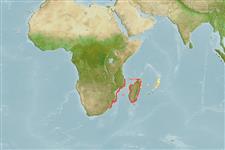>
Lophiiformes (Anglerfishes) >
Lophiidae (Goosefishes)
Etymology: Lophiodes: Greek, lophos = crest + Greek, suffix oides = similar to (Ref. 45335).
More on author: Regan.
Environment: milieu / climate zone / depth range / distribution range
पारिस्थितिकी
समुद्री बाथीड़िमरसल; गहराई सीमा 200 - 600 m (Ref. 4108). Deep-water; 12°S - 30°S
Western Indian Ocean: Natal in South Africa to northern Madagascar.
आकार / वज़न / Age
Maturity: Lm ? range ? - ? cm
Max length : 30.0 cm TL पुल्लिंग / अलिंग; (Ref. 4108)
Short description
पहचान कुंजी | आकृति विज्ञान | मौरफोमैटरिक्स
गुदा कांटा: 0; ऐनल सौफट रेज़: 6. Light to dark brown above, lighter below; pectorals and median fins pigmented as adjacent areas on body, anal fin darker distally, soft dorsal and caudal with interradial membranes lightly pigmented or unpigmented (Ref. 4108).
Feeds on fishes (Ref. 5213).
Life cycle and mating behavior
Maturities | पुनरुत्पत्ति | Spawnings | Egg(s) | Fecundities | लार्वा
Caruso, J.H., 1986. Lophiidae. p. 363-366. In M.M. Smith and P.C. Heemstra (eds.) Smiths' sea fishes. Springer-Verlag, Berlin. (Ref. 4108)
IUCN Red List Status (Ref. 130435)
Threat to humans
Harmless
Human uses
मात्स्यिकी: कोई रुचि बग़ैर
साधन
Special reports
Download XML
इंटरनेट स्रोत
Estimates based on models
Preferred temperature (Ref.
123201): 11.8 - 15.8, mean 14.2 °C (based on 17 cells).
Phylogenetic diversity index (Ref.
82804): PD
50 = 0.5000 [Uniqueness, from 0.5 = low to 2.0 = high].
Bayesian length-weight: a=0.01995 (0.00918 - 0.04336), b=3.00 (2.81 - 3.19), in cm total length, based on LWR estimates for this (Sub)family-body shape (Ref.
93245).
Trophic level (Ref.
69278): 4.2 ±0.73 se; based on food items.
लौटाव (Ref.
120179): माध्यम, न्यूनतम जनसंख्या दुगनी होने का समय 1.4 - 4.4 वर्ष। (Preliminary K or Fecundity.).
Fishing Vulnerability (Ref.
59153): Low vulnerability (20 of 100).
